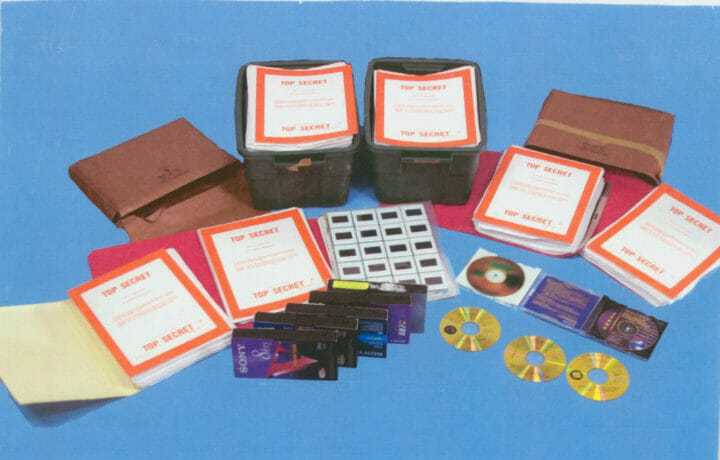He collated the TS/SCI materials from the National Reconnaissance Office and thought he would be able to parlay them into a set-for-life payday of more than $13 million by selling the cache of materials to the Governments of Iraq, Libya, and China. He was wrong.
On this date, March 21, 2003, Brian Patrick Regan was sentenced to life in prison by Judge Gerald Bruce Lee of Federal District Court.
Brian Regan
He retired from the Air Force as an E-7, MSGT, in August 2000. His specialty during his time in the Air Force was that of a signals intelligence analyst.
Regan worked for defense and intelligence community contractor, TRW, and in October 2001 was assigned to the NRO in support of one of the many contracts TRW enjoys within these communities. He had previously worked at the NRO as a member of the Air Force Intelligence, from 1995-2000.
The indictment of Regan shows that from mid-1999 through his Air Force retirement in August 2000, he conducted multiple searches on the classified information systems pertaining to the “military preparedness of Iran, Iraq, Libya and the People’s Republic of China.” The information which Regan sought was, as we have seen with many insiders who attempt to collect information outside their area of expertise, “unrelated to his official duties.”
Regan also had credit card debt in the neighborhood of $100,000.
Regan caught in the act
The FBI had been given a letter received at the Libyan consulate in New York by a confidential informant in December 2000. The letter was four pages in length and full of misspelling, read in part.
“I am a Middle East North African analyst for the Central Intelligence Agency,” the letter read. “I am willing to commit espionage against the US by providing your country with highly classified information. I am willing to commit espionage against the US by providing your country with highly classified information.”
Included in the letter were items marked “CLASSIFIED SECRET” and “CLASSIFIED TOP SECRET” – satellite images.
If Libya was interested, they should take an advertisement out in the classified section of the Washington Post and be prepared to pay $13 million.
The FBI investigation quickly pointed to the volunteer being located within the NRO. Using the misspellings within the letter sent to the Libyan consulate as a starting point, the investigation eventually led to Regan. When August 2001 rolled around, Regan was under FBI surveillance.
On August 15, 2001, an FBI surveillance camera caught Regan in the act of copying NRO information at his desk.
In fact, the investigators found that during the month of August, Regan had collected classified information related to military facilities in Iraq, China, Iran, and Libya, as well as classified documents which detailed the current United States intelligence collection capabilities against each of those countries.
There is no doubt Regan knew that what he was doing was espionage and his attempts at tradecraft to separate himself from the stolen information was interesting. Apparently, during the course of his information acquisition forays, he buried the stolen materials in various in-ground caches (19 total). He then recorded the locations of the caches on a piece of paper that he secreted inside a toothbrush holder. He then hid that toothbrush holder in a secret location, buried under an I-95 exit sign near Fredericksburg, VA.
The FBI arrested Regan on August 23 at Dulles International Airport as he was attempting to board a flight to Switzerland. He had in his possession encrypted notes and a list of contact information associated with a number of diplomatic offices – and a plethora of incriminating documents and notes.
A search of Regan’s home found that he had reached out to the governments of Libya, Iraq, and China offering to sell the classified information. In fact, he had asked Saddam Hussein for $13 million – the same amount he had requested Libya.
Regan’s plea
While the investigation of Regan did not turn up the caches, it was only when Regan agreed to cooperate, in exchange for life in prison (prosecutors had requested the death penalty) and then led the FBI to the cache of materials that the breadth of Regan’s collection effort became known. His haul? Regan had taken approximately 20,000 pages of classified materials, videotapes, and computer disks and buried them, in what appeared to be Rubbermaid containers, at a variety of Virginia and Maryland state parks.
An additional provision of the plea agreement was that his spouse would continue to receive a portion of his Air Force pension and would not be prosecuted.
At his sentencing, Regan apologized and told the judge, “I feel a life sentence is excessive in my case. I never harmed anyone. I’m entering into this to protect my family.”
Judge Lee had none of it and responded, ”You betrayed your country’s trust. There’s no doubt that your attempted espionage put our nation’s intelligence-gathering at risk.”
Regan has been assigned federal prisoner number 41051-083, and currently resides at the Hazelton Federal Correctional Institution in Bruceton Mills, WV.
To read more about Regan and his attempted espionage, read “The Spy Who Couldn’t Spell” by Yudhijit Bhattacherjee.




